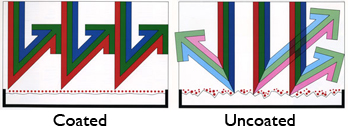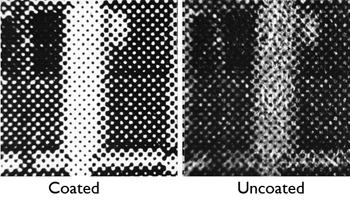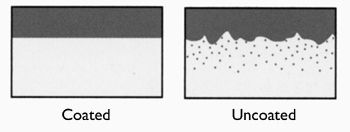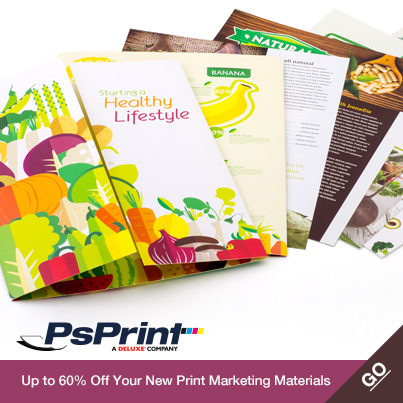When it comes to selecting a paper stock for a project many times it comes down to personal preference. Most designers will consider the message of the piece and the audience, or what kind of artwork or photography is being used. The tactile feel of the paper can range from slick to velvety to downright rough. I find that if I’m selling a hard product with glossy slick photos that a gloss stock seems right. If I’m selling a luxury item I may use a coated matte stock. If I’m selling a service such as spa treatments I may use an uncoated stock. Papers can be coated, which means they have a layer of clay on them, or uncoated without the layer of clay. The finishing step of the paper-making process is called calendaring, which is sort of like polishing. The more it’s polished, the shinier the paper gets.  If you have ever printed four-color process images on uncoated paper you probably noticed that the image seemed slightly soft or dull. When light hits coated paper all of the reflected light enters our eye giving us a bright, vivid colorful image. When light hits an uncoated paper stock with a color image on it the light is dispersed. Since the light is scattered, this leaves us to perceive a less vividly colored image. Sometimes this is the effect we are trying to achieve and sometimes we want a sharper image.
If you have ever printed four-color process images on uncoated paper you probably noticed that the image seemed slightly soft or dull. When light hits coated paper all of the reflected light enters our eye giving us a bright, vivid colorful image. When light hits an uncoated paper stock with a color image on it the light is dispersed. Since the light is scattered, this leaves us to perceive a less vividly colored image. Sometimes this is the effect we are trying to achieve and sometimes we want a sharper image. If you have ever printed four-color process images on uncoated paper you probably noticed that the image seemed slightly soft or dull. When light hits coated paper all of the reflected light enters our eye giving us a bright, vivid colorful image. When light hits an uncoated paper stock with a color image on it the light is dispersed. Since the light is scattered, this leaves us to perceive a less vividly colored image. Sometimes this is the effect we are trying to achieve and sometimes we want a sharper image.
If you have ever printed four-color process images on uncoated paper you probably noticed that the image seemed slightly soft or dull. When light hits coated paper all of the reflected light enters our eye giving us a bright, vivid colorful image. When light hits an uncoated paper stock with a color image on it the light is dispersed. Since the light is scattered, this leaves us to perceive a less vividly colored image. Sometimes this is the effect we are trying to achieve and sometimes we want a sharper image.  The images above are of the some screened image printed on coated and uncoated stock. A factor to keep in mind is dot gain. Ink will be absorbed by uncoated paper. This causes the dot to expand. You should plan on a 15 percent dot gain when printing on uncoated stock. On coated stock the ink stays on the surface. This may add to drying time. In the end what matters is that we conveyed the message that we intended clearly, that the graphics and copy are easy to read, and that the piece works for your client.
The images above are of the some screened image printed on coated and uncoated stock. A factor to keep in mind is dot gain. Ink will be absorbed by uncoated paper. This causes the dot to expand. You should plan on a 15 percent dot gain when printing on uncoated stock. On coated stock the ink stays on the surface. This may add to drying time. In the end what matters is that we conveyed the message that we intended clearly, that the graphics and copy are easy to read, and that the piece works for your client.
Stock options: Coated and uncoated paper stock
March 13, 2009
Burning your candle at both ends burns othersPrint marketing: 7 benefits to leverage in your business










No comments yet.